Wonky Carrots: What causes carrots to deform
 Many of us have had the sad experience of pulling up our carrots only to find them forked, twisted, branching or knobby. Unfortunately, there isn’t much you can do once your carrots start to deform. There are many different factors that cause these issues ranging from how you prepare your soil to garden pests. Firstly, are freaky carrots still edible? In most cases, yes, they are, you can eat them as is or add them to soups, stews, smoothies and more so don’t throw them out yet. While you can find carrot varieties that can handle many soil conditions, it’s wise to look at your own garden for clues. If you can grow great carrots, why not do a little investigating. If you can’t repair your soil conditions, look at growing carrot varieties with blunt-tipped ends i.e., ‘Little Fingers’.
Many of us have had the sad experience of pulling up our carrots only to find them forked, twisted, branching or knobby. Unfortunately, there isn’t much you can do once your carrots start to deform. There are many different factors that cause these issues ranging from how you prepare your soil to garden pests. Firstly, are freaky carrots still edible? In most cases, yes, they are, you can eat them as is or add them to soups, stews, smoothies and more so don’t throw them out yet. While you can find carrot varieties that can handle many soil conditions, it’s wise to look at your own garden for clues. If you can grow great carrots, why not do a little investigating. If you can’t repair your soil conditions, look at growing carrot varieties with blunt-tipped ends i.e., ‘Little Fingers’.Soil Conditions
Let’s look at your soil preparation first. As carrots grow, they are highly sensitive to soil conditions. Any obstacle like a rock, soil clod, large root, wood etc.… will cause a carrot root to change its direction leading to malformation of some kind. Too much nitrogen in the soil can also cause branching. Compacted soils or heavy soils full of clay will make it hard for carrots to penetrate and thus result in short, stumpy carrots. The best type of soil for growing carrots is deep (12’ deep), loose, sandy loam amended with ample compost and well-aged manure or a balanced fertilizer (5-10-10). Remove the rocks and large clods and aim to increase your soil health overall.
Dense Plantings
Studies have found a clear relationship between carrot plant density and the number of deformed roots. The higher the density, the more the deformities. To prevent this problem, thin your seedlings when they are 3-4 inches tall.
Weeds
Weeds will compete with your carrots for space, soil nutrients, water, oxygen, and light. Ensure your carrot beds are regularly weeded.
Transplanting
Carrots are also highly sensitive to disturbance. They just don’t like being messed with, so it is better to sow seeds rather than transplant them when they are older.
Seasonality
Carrots, being biennials like kale, grow through two seasons; they have a first year and a second year. When this years’ carrots are left in the ground over winter, they will start growing again come spring but in this second year they will be in seed-making mode. The roots will become pithy, less tasty and start to branch naturally. Unless you want carrot seed, harvest your carrots in the first year.
Pest & Disease
 Microscopic worms called root-knot nematodes create small galls or knots on the roots. You can sometimes identify this culprit because the plant tops often look wilted or stunted but when you pull the carrot up, you will see the hairy, galled and knotted up carrot. Once the nematodes have infected the carrots, there is no treatment except to remove the affected plants. Prevention is the cure! Before you plant carrot seed again, remove all infected plant material and do not compost it. Harvest your spring crop early before these nematodes establish themselves. Rotate your carrot crop area with non-host plants in the cabbage or grass family or, hairy vetch and asparagus. Interplant with marigolds which have been proven to thwart root-knot nematodes. Add organic matter.
Microscopic worms called root-knot nematodes create small galls or knots on the roots. You can sometimes identify this culprit because the plant tops often look wilted or stunted but when you pull the carrot up, you will see the hairy, galled and knotted up carrot. Once the nematodes have infected the carrots, there is no treatment except to remove the affected plants. Prevention is the cure! Before you plant carrot seed again, remove all infected plant material and do not compost it. Harvest your spring crop early before these nematodes establish themselves. Rotate your carrot crop area with non-host plants in the cabbage or grass family or, hairy vetch and asparagus. Interplant with marigolds which have been proven to thwart root-knot nematodes. Add organic matter.
Another culprit, Aster Yellows Phytoplasma is spread by leafhoppers. The disease causes pale, bronze-yellow leaves with green veins, curling foliage and deformed flowers and roots. Prevent this infection by mulching with aluminum foil or oat straw which will reflect sunlight from the soil and dissuade the leafhoppers from going near your carrots. Alternatively, grow your carrots under row covers to keep leafhoppers away. Throw out all affected carrots – do not compost.

For more information on dealing with carrot deformities check out Wonky Carrots: How to Avoid Deformed & Distorted Carrots






